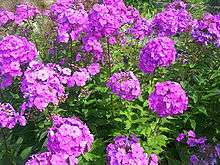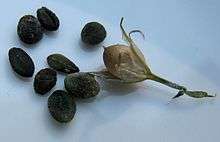Phlox
| Phlox | |
|---|---|
 | |
| Phlox paniculata (Garden Phlox) | |
| Scientific classification | |
| Kingdom: | Plantae |
| (unranked): | Angiosperms |
| (unranked): | Eudicots |
| (unranked): | Asterids |
| Order: | Ericales |
| Family: | Polemoniaceae |
| Genus: | Phlox L. |
| Species | |
|
See text | |
Phlox (/ˈflɒks/; Greek φλόξ "flame"; plural "phlox" or "phloxes", Greek φλόγες phlóges) is a genus of 67 species of perennial and annual plants in the family Polemoniaceae. They are found mostly in North America (one in Siberia) in diverse habitats from alpine tundra to open woodland and prairie. Some flower in spring, others in summer and fall. Flowers may be pale blue, violet, pink, bright red, or white. Many are fragrant.
Fertilized flowers typically produce one relatively large seed. The fruit is a longitudinally dehiscent capsule with three or more valves that sometimes separate explosively.[1]
Some species such as P. paniculata (garden phlox) grow upright, while others such as P. subulata (moss phlox, moss pink, mountain phlox) grow short and matlike.
The foliage of Phlox is a food for the larvae of some Lepidoptera species including dot moth, Gazoryctra wielgusi, hummingbird hawk-moth and Schinia indiana (which feeds exclusively on P. pilosa). Phlox species are also a popular food source for groundhogs, rabbits and deer.
Species



The species in the genus include:[2]
- Phlox aculeata A. Nelson
- Phlox acuminata Pursh
- Phlox adsurgens Torr. ex A. Gray
- Phlox alaskensis Jordal
- Phlox albomarginata M.E. Jones
- Phlox alyssifolia Greene
- Phlox amabilis Brand
- Phlox amoena Sims
- Phlox amplifolia Britton
- Phlox andicola (Britton) E.E. Nelson
- Phlox austromontana Coville
- Phlox azurea Glad. L. Sm.
- Phlox bifida L.C. Beck
- Phlox bryoides Nutt.
- Phlox buckleyi Wherry
- Phlox caespitosa Nutt.
- Phlox canescens Torr. & A. Gray
- Phlox carolina L.
- Phlox caryophylla Wherry
- Phlox cluteana A. Nelson
- Phlox colubrina Wherry & Constance
- Phlox condensata (A. Gray) E.E. Nelson
- Phlox covillei E.E. Nelson
- Phlox cuspidata Scheele
- Phlox diffusa Benth.
- Phlox dispersa Sharsm.
- Phlox divaricata L.
- Phlox dolichantha A. Gray
- Phlox douglasii Hook.
- Phlox drummondii Hook.
- Phlox floridana Benth.
- Phlox glaberrima L.
- Phlox glabriflora Whiteh.
- Phlox gladiformis (M.E. Jones) E.E. Nelson
- Phlox glutinosa Buckley
- Phlox grahamii Wherry
- Phlox grayi Wooton & Standl.
- Phlox griseola Wherry
- Phlox hendersonii (E.E. Nelson) Cronquist
- Phlox hentzii Nutt.
- Phlox hirsuta E.E. Nelson
- Phlox hoodii Richardson
- Phlox idahonis Wherry
- Phlox jonesii Wherry
- Phlox kelseyi Britton
- Phlox lanata Piper
- Phlox lighthipei Small
- Phlox linearifolia (Hook.) A. Gray
- Phlox longifolia Nutt.
- Phlox longipilosa Waterf.
- Phlox lutescens (S.L. Welsh) S.L. Welsh
- Phlox maculata L.
- Phlox mesoleuca Greene
- Phlox mollis Wherry
- Phlox multiflora A. Nelson
- Phlox muscoides Nutt.
- Phlox nana Nutt.
- Phlox nivalis Lodd.
- Phlox oklahomensis Wherry
- Phlox ovata L.
- Phlox paniculata L.
- Phlox pattersonii Prather
- Phlox peckii Wherry
- Phlox pilosa L.
- Phlox pulcherrima (Lundell) Lundell
- Phlox pulvinata (Wherry) Cronquist
- Phlox pungens Dorn
- Phlox richardsonii Hook.
- Phlox roemeriana Scheele
- Phlox sibirica L.
- Phlox speciosa Pursh
- Phlox stansburyi (Torr.) A. Heller
- Phlox stolonifera Sims
- Phlox subulata L.
- Phlox suksdorfii (Brand) H. St. John
- Phlox superba Brand
- Phlox tenuifolia E.E. Nelson
- Phlox tenuis (A. Gray) E.E. Nelson
- Phlox texensis (Lundell) Lundell
- Phlox triovulata Thurb. ex Torr.
- Phlox tumulosa Wherry
- Phlox viridis E.E. Nelson
- Phlox viscida E.E. Nelson
- Phlox walteri (A. Gray) Chapm.
- Phlox woodhousei (A. Gray) E.E. Nelson
Cultivation

Several species and cultivars of phlox are commonly grown in gardens. Most cultivated phlox, with the notable exception of Phlox drummondii, are perennial. Species from Alpine habitats (and cultivars derived from them) require full sun and good drainage. Those from woodland habitats (such as P. divaricata) require partial shade and soil rich in humus. Those from waterside habitats (such as P. paniculata) require full sun and moisture at the roots.[3] Phlox are valued in the garden for their ability to attract butterflies. Phlox can be propagated from stem cuttings.
References
- ↑ Klaus Kubitzki (2004). Flowering plants, Dicotyledons: Celastrales, Oxalidales, Rosales, Cornales, Ericales. Springer. p. 311.
- ↑ The Plant List: A Working List of All Plant Species, retrieved May 20, 2016
- ↑ Prof. Craigmyle, M., The Illustrated Encyclopedia of Perennials, Salamander Books Ltd, 2002, p222 ISBN 1 901683 78 8
External links
- Dole, Claire H. (2000). "Phlox: A Butterfly and Moth Magnet". Retrieved 2007-05-08.
| Wikimedia Commons has media related to Phlox. |
 Chisholm, Hugh, ed. (1911). "Phlox". Encyclopædia Britannica. 21 (11th ed.). Cambridge University Press. p. 447.
Chisholm, Hugh, ed. (1911). "Phlox". Encyclopædia Britannica. 21 (11th ed.). Cambridge University Press. p. 447.